June marked the 25th Anniversary of Gramercy! Thank you to our valued investors, trusted business partners and team members without whom this milestone could not have been reached. We are excited for the opportunities we see ahead, and look forward to continuing to deliver upon our mission to have a positive impact on the well-being of our clients, portfolio investments (and their communities) and our team members.
Contents
Market Overview
Macro Review
Fitch downgraded the U.S. credit rating to AA+. The news itself had little bearing on financial markets. After the S&P downgrade in August 2011, Moody’s are the only rating agency of importance that rates the U.S. at AAA. However, the equity sell-off was driven by CTA sellers of U.S. Treasury bonds. This in turn triggered credit derivatives and cash bonds to widen and even weighed on DXY, which subsequently re-priced EMFX. The notable headlines were around the S&P 500 performance on Wednesday (-1.4%) as it recorded its worst day since April and as U.S. Treasury yields increased, the 2s10s slope receded back to levels last seen in May. Investors also found themselves asking how Bill Ackman had timed the sell-off to perfection. With the VIX increasing to its highest level since May, the knock-on effect across global markets was visible. Asian stocks only began to stem losses after an upbeat Chinese Caixin PMI was digested but weakness in the property sector was endemic. The PBoC had reiterated that it intends to step-up counter-cyclical adjustments, but such a statement lacked any concrete details. During a week where the market championed the beginning of the EM cutting cycle, sentiment had quickly soured. Chile cut by 100 bps last Friday, just as Brazil cut rates by 50 bps. Expectations of deeper cuts by year-end and in 2024 also increased, helping equity markets in the two respective countries outperform. The theme extended after non-farm payrolls, where the South African rand outperformed as rate cuts were priced in over the next 12 months. Elsewhere, the Reserve Bank of Australia and Czech National Bank kept policy unchanged, while the Bank of England and Bank of Thailand hiked by 25 bps. The market was left attempting to figure out what Governor Bailey meant by the “last mile” on the UK’s inflation fight. However, the Bank of Japan increased the yield tolerance on the 10-year government bond to 1.0% from 0.5%, while maintaining the band at 50 bps. The Central Bank was also active in buying government bonds on two occasions last week, having been absent since February. The move ultimately led to yields on the 10-year bond rising to nine-year highs. Finally, Turkey’s CPI reading rose to 47.8% from 38.2% in June, just as the CBRT raised its year-end forecast to 58%. However, the more notable theme was that monthly CPI rose by 9.5% and comfortably exceeded monthly inflation in Argentina. Argentina’s monthly inflation is currently running at 6.0% but peaked at 8.4% in April.
EM Credit Update
Emerging market sovereign credit (cash bonds) ended the week down 1.4% with credit spreads 4 bps wider. Credit spreads held up relatively well in EM in what was the worst week for U.S. Treasury bonds in 2023. Sovereign outperformers were Ghana, El Salvador and Pakistan, while Tunisia, Zambia and Ukraine underperformed. A notable outperformer was the oil & gas sector. This was in part helped by crude oil trading above $85/bbl in response to Saudi Arabia’s unilateral production cut, which was extended by another month, along with a significant drawdown in U.S. inventories.
The Week Ahead
The focus of next week is on inflation. Will U.S. CPI hold steady and what will the reaction function from Fed officials be? Will China record a negative CPI surprise? A key barometer of sentiment will be how the market digests recent volatility in fixed income, especially as G10 central banks cut growth expectations. The Reserve Bank of Australia cut 2023 GDP down from 1.25% to 1.0%, while the Bank of England see GDP running at 0.2% in 3Q and 4Q. Key EM interest rate decisions are due from India (6.5%), Kenya (10.5%), Mexico (11.25%) and Romania (7.0%). Elsewhere, inflation data is due out from the Czech Republic, Hungary, Romania and Thailand, in addition to China. Otherwise, it may be worth watching out for further headlines around Tom Brady’s involvement in Birmingham City Football Club.
Highlights from emerging markets discussed below: The Central Banks of Brazil (BCB) and Chile (BCCh) begin rate-cutting cycles, Investigation for money laundering against Gustavo Petro’s son raises questions about potential implications for Colombia’s embattled President, and Ghana presented solid mid-year budget aligned with IMF.
Fixed Income
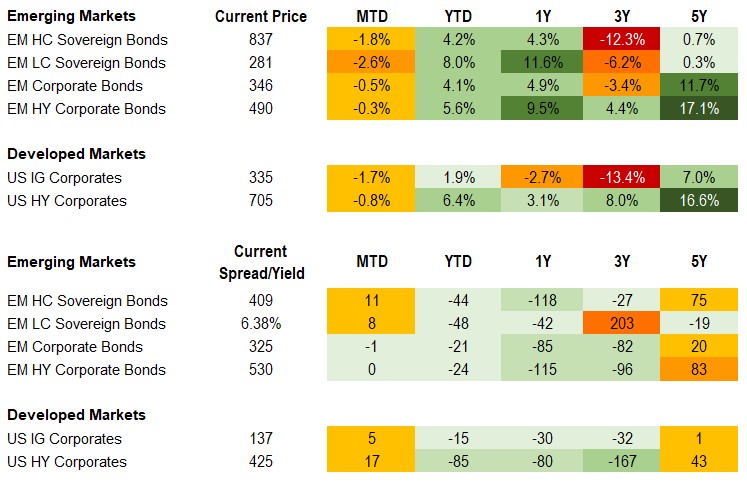
Equities
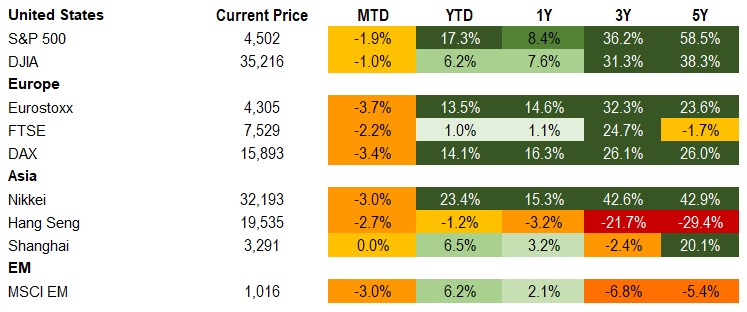
Commodities

Source for data tables: Bloomberg, JPMorgan, Gramercy. EM Fixed Income is represented by the following JPMorgan Indicies: EMBI Global, GBI-EM Global Diversified, CEMBI Broad Diversified and CEMBI Broad High Yield. DM Fixed Income is represented by the JPMorgan JULI Total Return Index and Domestic High Yield Index. Fixed Income, Equity and Commodity data is as of August 4, 2023 (mid-afternoon).
Emerging Markets Weekly Highlights
The Central Banks of Brazil (BCB) and Chile (BCCh) begin rate-cutting cycles
Event: This week, the BCB initiated a long-anticipated monetary policy easing cycle cutting its main SELIC rate by 50 bps to 13.25%. Late last week, BCCh lowered its main TPM rate by 100 bps to 10.25%, becoming the first major EM Central Bank to start unwinding policy tightening delivered in the high inflation post-pandemic environment.
Gramercy commentary: Both monetary policy actions were more aggressive than consensus market expectations of 25 bps and 75 bps cuts, respectively. The Central Banks of Brazil and Chile have been on the forefront of early monetary policy response among EM economies in the context of elevated current inflation and unanchored medium-term inflation expectations in the wake of the global pandemic. The BCB started hiking back in March 2021 and delivered 1175 bps of SELIC increases by August 2022. The BCCh began its rate increases cycle in July 2021 and completed it in October 2022 with 1075 bps of cumulative hikes. In the context of aggressive policy tightening, headline inflation has come down to around 3% YoY from a peak of around 12% YoY in the case of Brazil, and to around 6% YoY from a peak of around 14% YoY in the case of Chile. EM economies such as Brazil and Chile that experienced proactive and pre-emptive monetary policy management in 2021-22 are now positioned to benefit from lowering interest rates that should support economic activity and general market sentiment. At the same time, still significant real rate buffers (both current and forward looking) are likely to continue to anchor attractive carry trades in their currencies even as rates move gradually lower.
Investigation for money laundering against Gustavo Petro’s son raises questions about potential implications for Colombia’s embattled President
Event: Nicolás Petro Burgos, President Gustavo Petro’s 37-year-old son, was indicted this week and faces charges on money laundering and illicit enrichment. Nicolas Petro has pleaded not guilty, while his father has denied any knowledge of or involvement in the alleged wrongdoing.
Gramercy commentary: The legal scandal involving his son is yet another episode in a long string of political and PR setbacks that have thus far derailed President Petro’s ambitious domestic reform agenda. This has been welcomed by markets concerned that Petro’s social and environmental priorities could undermine Colombia’s traditionally prudent public finances management framework. As such, significant gridlock that the President has faced during his first year in office translated into strong performance by hard currency assets and the COP. Now, his son’s legal problems add to the political headwinds for Petro as the scandal could further damage his public image as well as the willingness of political actors to cooperate on key legislative priorities going forward. Separately, any potential direct links to the President or his campaign could introduce new levels of political noise in the system, up to potential considerations of impeaching Petro. No Colombian president has ever been impeached and the prerogative to accuse and investigate a sitting president resides solely within the bi-cameral Congress. For now, we believe removing Petro from office is an unlikely possibility, but we will be monitoring closely for any signals that might emerge from the upcoming corruption trial against the President’s son.
Ghana presented solid mid-year budget aligned with IMF
Event: Finance Minister Ken Ofori-Atta presented the 2023 mid-year budget which entailed a better than envisaged turnout for 1H with an overall deficit of -0.8% of GDP (vs. -3.5% 1H target) on expenditure consolidation in the backdrop of softer revenue growth. In light of ongoing economic pressure, the government’s 2023 forecast for growth was revised down to 1.5% from 1.8% while the primary balance target was amended to -0.5% of GDP vs. 0.7% of GDP. The statement indicated that bondholder negotiations will continue with an expectation for resolution by year-end.
Gramercy commentary: We see this as supportive for the credit narrative as it provides near-term reassurance to fiscal targets and policies agreed under the new IMF facility. While revenue underperformance may continue to pose structural headwinds, the more prudent response with spending constraints is welcomed and should set the stage for a relatively seamless IMF review process later this quarter. More broadly, we continue to expect a solid cadence towards debt resolution later this year as incentives on both sides should remained aligned to do so.
Emerging Markets Technicals
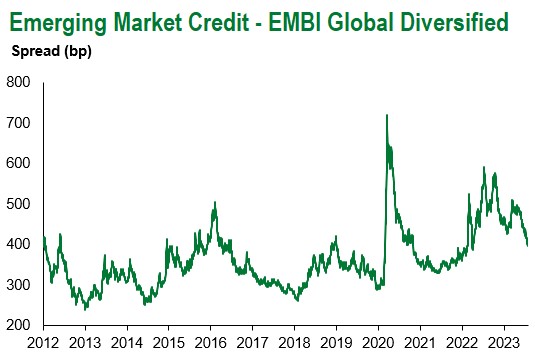
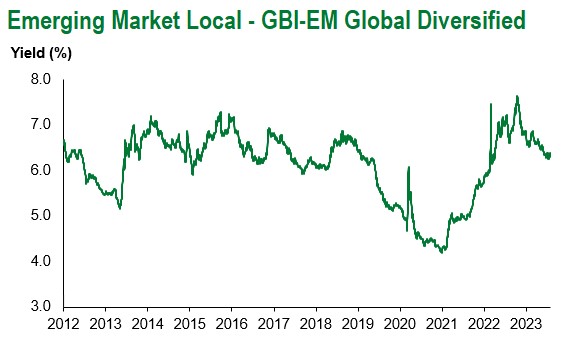
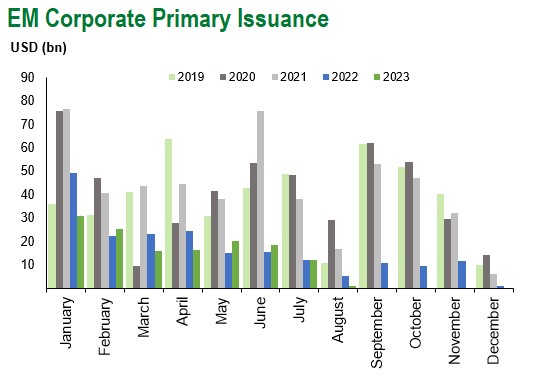
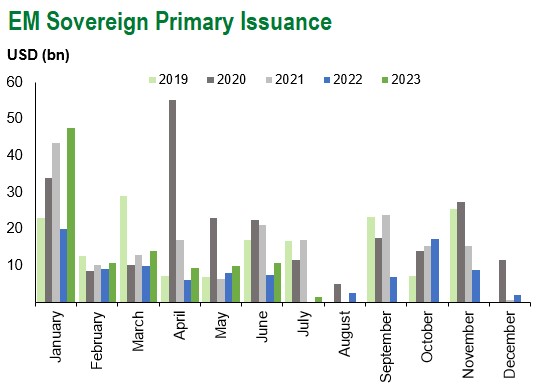
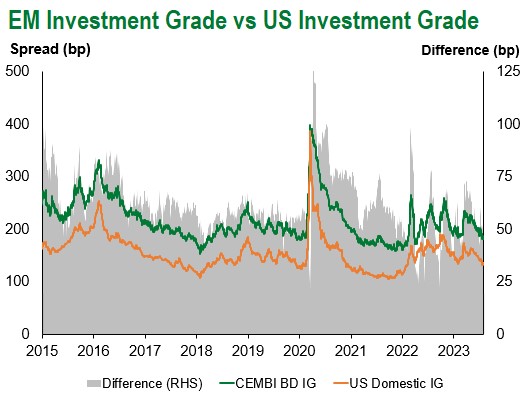
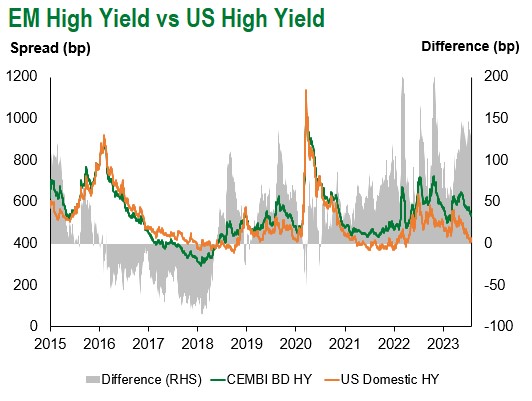
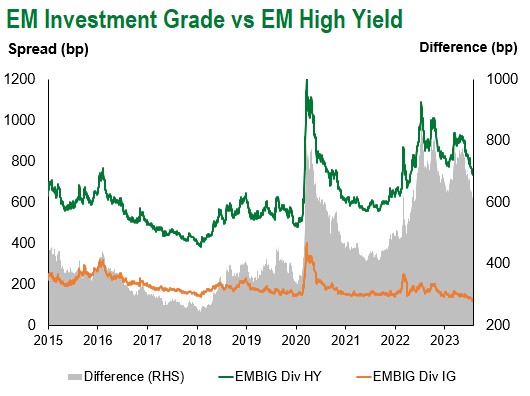
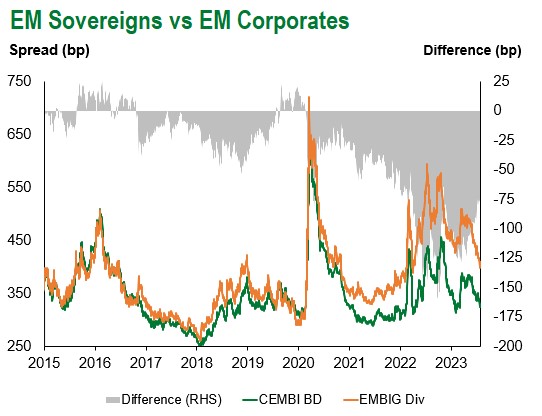
Emerging Markets Flows
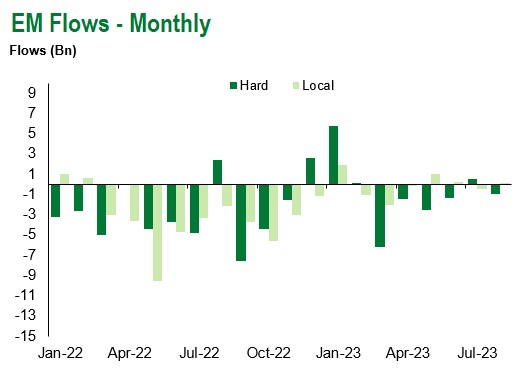
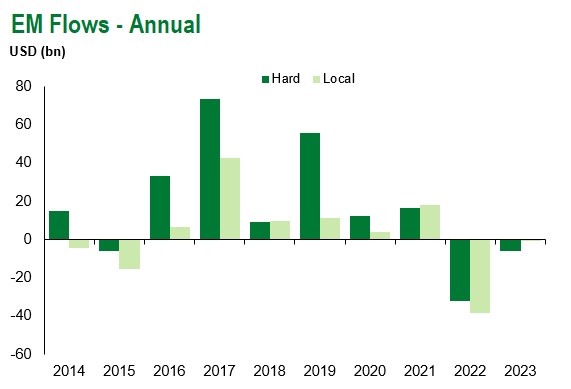
Source for graphs: Bloomberg, JPMorgan, Gramercy. As of August 4, 2023.
For questions, please contact:
Kathryn Exum, CFA ESG, Director, Co-Head of Sovereign Research, [email protected]
Petar Atanasov, Director, Co-Head of Sovereign Research, [email protected]
James Barry, Director, Deputy Portfolio Manager, [email protected]
This document is for informational purposes only. The information presented is not intended to be relied upon as a forecast, research or investment advice, and is not a recommendation, offer or solicitation to buy or sell any securities or to adopt any investment strategy. Gramercy may have current investment positions in the securities or sovereigns mentioned above. The information and opinions contained in this paper are as of the date of initial publication, derived from proprietary and nonproprietary sources deemed by Gramercy to be reliable, are not necessarily all-inclusive and are not guaranteed as to accuracy. This paper may contain “forward-looking” information that is not purely historical in nature. Such information may include, among other things, projections and forecasts. There is no guarantee that any forecasts made will come to pass. Reliance upon information in this paper is at the sole discretion of the reader. You should not rely on this presentation as the basis upon which to make an investment decision. Investment involves risk. There can be no assurance that investment objectives will be achieved. Investors must be prepared to bear the risk of a total loss of their investment. These risks are often heightened for investments in emerging/developing markets or smaller capital markets. International investing involves risks, including risks related to foreign currency, limited liquidity, less government regulation, and the possibility of substantial volatility due to adverse political, economic or other developments. References to any indices are for informational and general comparative purposes only. The performance data of various indices mentioned in this update are updated and released on a periodic basis before finalization. The performance data of various indices presented herein was current as of the date of the presentation. Please refer to data returns of the separate indices if you desire additional or updated information. Indices are unmanaged, and their performance results do not reflect the impact of fees, expenses, or taxes that may be incurred through an investment with Gramercy. Returns for indices assume dividend reinvestment. An investment cannot be made directly in an index. Accordingly, comparing results shown to those of such indices may be of limited use. The information provided herein is neither tax nor legal advice. Investors should speak to their tax professional for specific information regarding their tax situation.
